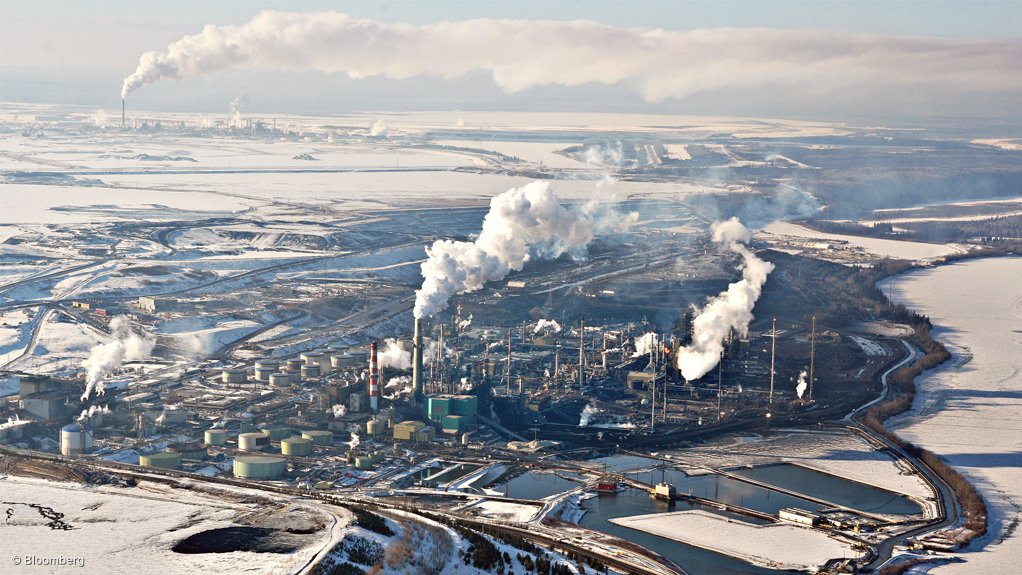TORONTO (miningweekly.com) – As the evacuation zone on Tuesday increased north of Fort McMurray, where a gigantic wildfire was spreading out of control, a top Canadian think tank estimated that the Alberta wildfires could have an impact of almost C1-billion on the local economy.
The Regional Municipality of Wood Buffalo (RMWB) late Monday expanded mandatory evacuation orders of several camps housing about 8 000 people.
Local operator Suncor Energy on Tuesday reported that it was evacuating personnel from the lodges on Aostra road and near its base plant facility to other lodges further north. As a precautionary measure, it had also staged an orderly shutdown of its base plant operations.
Shell Canada advised that its operations were not currently affected.
The wildfires had been raging since May 1 when the first evacuation orders were issued, prompting the Alberta provincial government to declare a state of emergency. According to government information, the Fort McMurray wildfire remained out of control on Tuesday, and was estimated to cover 355 000 ha.
As of late Tuesday afternoon, there were five new fire starts over the past 24 hours and a total of 17 wildfires were still burning, with four reported to be out of control. There were 1 754 firefighters, 208 helicopters, 412 pieces of heavy equipment and 29 air tankers currently deployed battling the fires.
“We know those who live and work in the Fort McMurray area have lots of questions, and we’re doing our best to answer them,” stated Premier Rachel Notley.
At least 12 oil sands operations were shut down and several more curtailed output this month because of the wildfire that closed pipelines and forced the evacuation of more than 80 000 people from the area.
ECONOMIC HIT
The Conference Board of Canada on Tuesday said it expected the total loss of oil sands production owing to the wildfires to average about 1.2-million barrels per day over 14 days, translating into roughly C$985-million in lost real gross domestic product (GDP) growth, or 0.33% of Alberta’s projected GDP in 2016. For Canada as a whole, that share was only 0.06%.
As the natural disaster unfolded, the board’s forecasters were looking at the immediate impact of the fires, how things would likely unfold in the coming days, weeks and months, and what effect the wildfires would have on the economy over the longer term.
The impact of the shutdown of activity in Fort Mac and in the oil sands represented a significant hit to the local economy in the short term. At provincial level, however, much of the economic activity lost in the city of Fort Mac would accrue elsewhere, the board stated.
The Conference Board expected that oil sands production would be lost to the province and to the country for some weeks, but how large the hit would be would depend on the length of the shutdown. Some producers had already started ramping up production again, and its assessment assumed that most would be up and running by the end of the month.
As residents returned to Fort Mac in the coming weeks, oil sands production was expected to get back to normal.
Meanwhile, while the evacuation orders remained in place, economic activity in Fort Mac had come to a grinding halt. Recent announcements from Notley suggested that the city would play a pivotal role in supplying goods and services to the massive oil sands industry.
The tragic events that saw estimates suggesting that more than 2 400 homes and structures were damaged or destroyed, and evacuation of workers from the area, resulted in many oil sands operations shutting down production.
REDUCED OUTPUT
According to Conference Board estimates, temporary shutdowns reduced oil sands output by more than one-million barrels a day – some of it crude bitumen, but most of it pricier upgraded synthetic crude oil.
“It is, however, still too early to get an accurate assessment of how long production will be shut down. Wildfires have so far not affected the production facilities directly, and most of them were shut down in an orderly way. This suggests that affected production facilities will be able to slowly resume operations as soon as workers are able to get back to the sites,” the board advised.
Suncor stated that it had enhanced fire mitigation and protection around all of its facilities. “When it is safe to do so, we will continue implementing our restart plans,” it said in a statement.
Auspice Capital Advisors founder and chief information officer Tim Pickering recently pointed out to Mining Weekly Online that if more than 500 000 bbl/d of oil was taken offline for a prolonged period, the storage cushion would be depleted.
According to Pickering, despite the wildfires, the Alberta oil industry had performed exceedingly well so far this year, citing the example that since Canadian crude’s low on January 20, the Canadian Crude Index had rallied in-step with the West Texas Intermediate benchmark, and tightened the price differential by as much as $1.
The Conference Board expected the reconstruction of Fort McMurray to gain traction during 2017 and, over the next few years construction activity would likely return to its peak levels of between 600 to 800 homes a year as residential and other infrastructure was rebuilt.
Total rebuilding efforts could add about $1.3-billion in real GDP to Alberta’s economy in 2017 — or about 0.4% points to economic growth. Construction would likely remain elevated in 2018, and possibly into 2019, as well until rebuilding had been completed, the board advised.
Edited by: Samantha Herbst
Creamer Media Deputy Editor
EMAIL THIS ARTICLE SAVE THIS ARTICLE
To subscribe email subscriptions@creamermedia.co.za or click here
To advertise email advertising@creamermedia.co.za or click here













